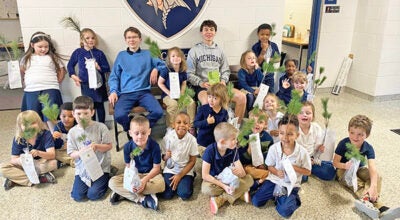Elders village nationally regarded
Published 11:07 pm Wednesday, October 6, 2010
By JOHN EBY
Dowagiac Daily News
To express their gratitude to the federal government for a $2 million stimulus grant through President Barack Obama’s American Recovery and Reinvestment Act (ARRA), the Dowagiac-based Pokagon Band of Potawatomi Indians Wednesday morning presented Kevin Fitzgibbons with a beaded “teaching stick.”
Val Janowski, an administrator in the housing department, made the presentation to Fitzgibbons.
“It was beaded by George Martin, a respected and renowned beadwork artist,” she said. “It’s used to draw in on Mother Earth and illustrate as a person teaches. It represents our gratitude for all HUD’s help and support.”
“It’s great to have someone with her enthusiasm as an ambassador for the Band,” he said in return.
Fitzgibbons is administrator of the Eastern Woodlands Office of Native American Programs (EWONAP) of the U.S. Department of Housing and Urban Development (HUD) in Chicago.
“This is really a significant event,” Fitzgibbons said, so much so that “we need to take a step back. We lose track of how great things are. We have the benefit of working with all of the tribes east of the Mississippi River and in the states of Minnesota and Iowa — roughly 60 federally-recognized tribes.
“There is not a tribe,” he continued, “that has made the progress of the Pokagon Band. You have done an unbelievable amount of good things in the last five, six, seven years, starting with the elders village, which is renowned nationally because it was one of the first Indian housing projects in the country to fully address the issues of sustainability.”
“We have showed our PowerPoint presentation on the elders village to just about every tribe in the country. It shows how advanced you have been,” Fitzgibbons said. “HUD itself just formed an Office of Sustainable Communities. Clearly, sustainability is something we encourage and we really look forward to projects such as yours. What’s being done with the vegetated roof, solar panels and geothermal all speak to what we want to be as a federal agency in terms of encouraging alternative energy. These great things would never happen if it weren’t for two things — tribal leadership and vision. You are so blessed to have both of those going for you. You do not see this anywhere else in the country.”
Fitzgibbons noted he also received a present Tuesday night from his daughter for his birthday — two tickets for the Notre Dame-Pittsburgh game on Saturday, so “I’ll be seeing you again soon.”
“We appreciate very much the relationship that we have with them,” Tribal Chairman Matt Wesaw said. “This building represents the latest project for our rapidly-growing community, and one that we’re very proud of. We’re proud that this project won a $2 million competitive stimulus earmarked for Indian tribes. We’re proud that this project is also supported by the Bureau of Indian Affairs’ through its Indian Reservation Roads program. We’re proud that this 8,500-square-foot building will give tribal citizens a central place to gather for meetings, social events and special occasions.”
At the 10:30 a.m. blessing of the community center under construction at Pokégnek Édawat, which now has almost 30 homes, Wesaw said the facility will feature a large meeting room, office space, a large conference room divisible into two smaller spaces, a lounge area, kitchen and wall cases to hold cultural items.
Outside, there will be a large patio with a fire pit and nearly 100 parking spaces.
“We’re proud, too,” Wesaw said, “that this space will be tangible evidence of our mission statement to preserve Mother Earth by including a host of green features, including solar panels and a section of the roof that will support the growth of live native plants.”
This vegetated green roof will help insulate the building and reduce water runoff.
Another feature is a geothermal heating and cooling system that will improve comfort and reduce both energy dependence and operating costs.
The large meeting room with a southern orientation and glass walls will use passive solar to maximize daylight and manage heat gain, Wesaw said.
A 12-inch concrete floor in the main space will act as a heat sink that will help retain heat in the winter by absorbing radiant sunlight.
Also planned is the use of porous pavers rather than asphalt in the parking lot to reduce stormwater runoff.
The building and site will meet the U.S. Green Building Council’s requirements for a Silver LEED rating.
“If all goes as planned,” Wesaw said, “we’ll all be gathered here next (July) for a ribbon-cutting and a celebratory feast inside. We have a lot to be proud of, much to celebrate and many reasons to be grateful. This is a proud day for all of us.”
To commemorate the building of the community center, the tribe’s spiritual leader, Clarence White, assisted by resource developer Kevin Daugherty, conducted a sacred pipe ceremony with tobacco during which photography is prohibited.
Majority Builders Inc. of South Bend, Ind., and Wightman and Associates Inc. took part in the ceremony.
White clasped the pipe in his left hand, closest to his chest after blowing a whistle to summon spirits.
He faces east, then south, west and north.
Women who don’t smoke he taps on the shoulder with the pipe because “we don’t want to get you started,” but state Rep. Sharon Tyler, R-Niles, joined the men in puffing on the pipe.
“Without the women we men would not be here,” White said reverently.
At the tent just down Dailey Road from the campus of Southwestern Michigan College, Andi Jackson led the women’s song for the water and its special powers.






